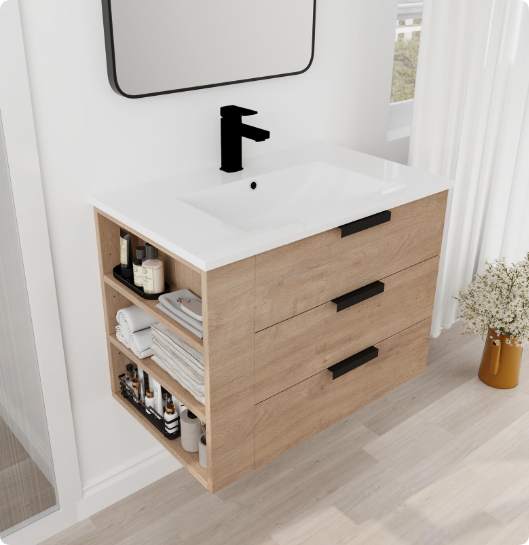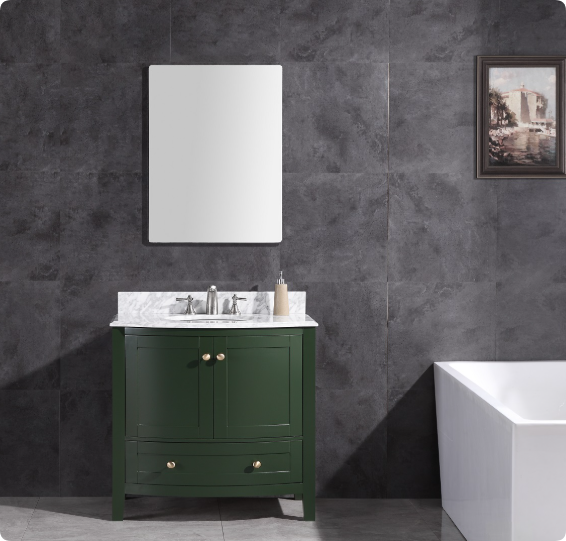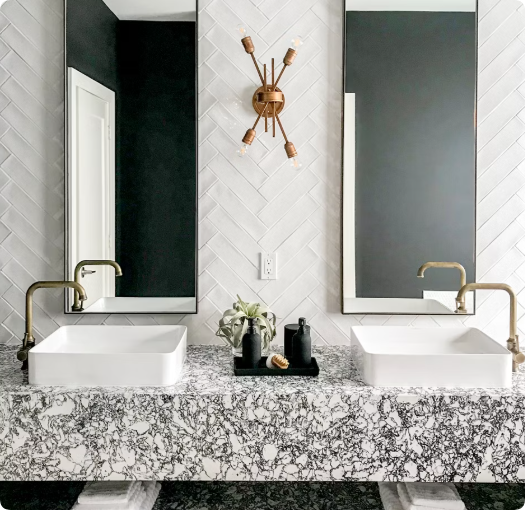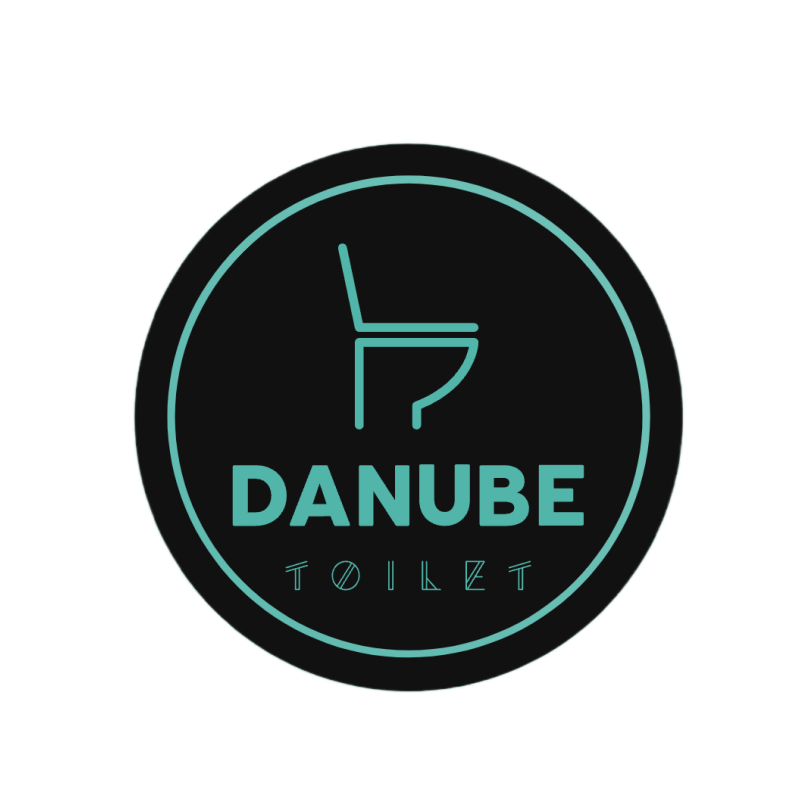Vanities in bathrooms are often exposed to moisture, humidity, and even occasional splashes of water. Choosing the right material for a vanity that can withstand these elements is crucial for longevity and maintaining aesthetic appeal. But with so many materials available, how do you choose the best one? This article explores the different materials used for waterproof vanities, clarifies common misconceptions, showcases design trends, and includes real-world examples to guide your decision.
1. Introduction to Waterproof Materials for Vanities
Bathrooms are one of the most humid spaces in a home, where moisture levels fluctuate daily. Choosing the wrong material for your vanity could lead to warping, mold growth, or even total material failure. This is why understanding the best waterproof materials for bathroom vanities is essential. The market is filled with a variety of options, but not all materials are created equal when it comes to durability and moisture resistance.
Key Considerations for Choosing Waterproof Materials:
- Moisture Resistance: The material must be able to resist absorption and prevent water damage.
- Durability: It should be long-lasting, resistant to scratches, stains, and general wear and tear.
- Aesthetic Appeal: Waterproof materials should also look attractive and complement the overall bathroom design.
- Maintenance: Some materials are easier to clean and maintain than others.
- Cost: The price can vary significantly, so balancing quality with budget is important.
Types of Waterproof Materials for Vanities
There are several materials that can be used for waterproof vanities, each with its unique advantages and disadvantages. The following is a breakdown of the most common options:
- Solid Wood (With Waterproof Coating)
- MDF (Medium Density Fiberboard) with Laminate Finish
- Plywood with Veneer or Laminate
- PVC (Polyvinyl Chloride)
- Stainless Steel
- Stone (Granite, Marble, Quartz)
2. Detailed Comparison of Waterproof Vanity Materials
Let’s dive deeper into the characteristics of each material, analyzing their suitability for bathroom vanities and the pros and cons of each.
2.1 Solid Wood (With Waterproof Coating)
Wood is a classic choice for bathroom vanities, but without a proper waterproof coating, it can warp and swell. When treated with the right finish, however, wood can be a great option for a stylish and waterproof vanity.

Advantages:
- Aesthetic Appeal: Wood has a natural beauty that can bring warmth and elegance to any bathroom design.
- Customization: Can be stained or painted to match any design style.
- Strength and Durability: When treated properly, solid wood can last for years.
Disadvantages:
- Vulnerability to Water: Solid wood without a protective coating can warp, rot, and become susceptible to mold in high-humidity environments.
- Higher Maintenance: Needs periodic resealing or refinishing to maintain its waterproofing.
Best for:
- High-end, traditional bathroom designs where aesthetics and durability are paramount.
2.2 MDF with Laminate Finish
Medium Density Fiberboard (MDF) is an engineered wood product, often used in vanity construction. It’s typically finished with a laminate that provides moisture resistance.

Advantages:
- Cost-Effective: MDF is more affordable than solid wood.
- Smooth Surface: Provides a clean, modern look that works well with laminate finishes.
- Good Moisture Resistance: Laminate provides a layer of protection against water.
Disadvantages:
- Vulnerability to Severe Water Exposure: If the laminate is damaged, MDF can absorb water and swell.
- Not as Durable as Solid Wood: MDF is less strong and can dent or scratch easily.
Best for:
- Budget-conscious bathroom renovations, especially for those looking for a modern, sleek look without breaking the bank.
2.3 Plywood with Veneer or Laminate
Plywood, when combined with veneer or laminate, offers a good balance of strength and resistance to moisture. It’s often used in more affordable vanities.

Advantages:
- Strong and Stable: More durable than MDF and less prone to warping.
- Affordable Option: Generally cheaper than solid wood but offers a similar aesthetic appeal when covered with veneer or laminate.
Disadvantages:
- Veneer Durability: If the laminate or veneer begins to peel or get damaged, the underlying wood can be exposed and vulnerable to moisture.
- Limited High-End Aesthetic: May not offer the luxurious look of solid wood.
Best for:
- Affordable vanity solutions for smaller bathrooms or more budget-conscious projects.
2.4 PVC (Polyvinyl Chloride)
PVC vanities are made entirely from plastic materials, offering strong waterproof properties without the risk of water absorption.

Advantages:
- 100% Waterproof: PVC does not absorb water, making it highly resistant to the humidity found in bathrooms.
- Durability: Extremely durable, resistant to scratches, stains, and warping.
- Low Maintenance: Easy to clean and maintain.
- Affordable: Generally cheaper than wood or stone options.
Disadvantages:
- Aesthetic Limitations: PVC doesn’t have the same luxurious look as natural wood or stone, though modern designs can mimic wood textures.
- Not as Sturdy as Wood or Stone: While durable, PVC lacks the substantial feel of natural materials.
Best for:
- Budget-friendly and practical vanities, especially in highly humid environments.
2.5 Stainless Steel
Stainless steel is often seen in more modern or industrial-style bathroom designs.
Advantages:
- Waterproof and Hygienic: Stainless steel is non-porous, preventing mold or bacteria buildup.
- Modern Aesthetic: Provides a sleek, contemporary look that suits minimalistic designs.
- Durability: Very resistant to scratches, stains, and dents.
Disadvantages:
- Prone to Scratches: While durable, stainless steel can scratch over time.
- Cold Appearance: Not ideal for traditional or rustic bathroom designs.
Best for:
- Modern or industrial-style bathrooms.
2.6 Stone (Granite, Marble, Quartz)
Stone materials, particularly granite, marble, and quartz, are often used in high-end bathroom vanities due to their elegance and durability.

Advantages:
- Natural Beauty: Offers a luxurious, timeless aesthetic.
- Water and Stain Resistance: Especially quartz, which is engineered to resist water absorption.
- Durability: Very strong, resistant to wear, and can last for decades.
Disadvantages:
- High Cost: Stone can be quite expensive.
- Maintenance: Requires periodic sealing to maintain its water resistance (especially marble).
Best for:
- Luxury bathrooms and those seeking a high-end, sophisticated look.
3. Common Misconceptions About Waterproof Materials
When selecting a waterproof material for your vanity, several misconceptions often arise. Let’s clear them up.
Myth 1: “All Stone is Suitable for Wet Environments”
Not all stone is suitable for bathrooms. For example, while granite and quartz are ideal for vanities due to their moisture resistance, softer stones like marble can absorb water and stain easily if not sealed regularly. Always check the material’s specifications before installation.
Myth 2: “PVC is Cheap and Unattractive”
While PVC may be affordable, it doesn’t mean it lacks style. Modern PVC vanities come in various designs and finishes, some even mimicking the appearance of wood or stone. Its strength and practicality make it a solid choice for bathrooms in need of a budget-friendly yet durable option.
Myth 3: “All Waterproof Materials Are Maintenance-Free”
While materials like PVC are low-maintenance, wood, stone, and even MDF require periodic upkeep. For example, wooden vanities need resealing to maintain their waterproofing, while stone surfaces may need resealing every few years.
4. Design Trends and Cases: How to Integrate Waterproof Materials into Your Bathroom Design
When it comes to bathroom design, functionality and aesthetics should work hand-in-hand. Below are some popular trends in bathroom vanities and how you can pair them with the right waterproof materials.
4.1 Minimalist Modern Designs with PVC or Stainless Steel
Modern bathrooms often feature minimalist designs with clean lines, neutral colors, and sleek materials like stainless steel or PVC. These materials are perfect for a contemporary look, offering both function and style.
Case Study:

A renowned designer recently created a high-end hotel bathroom using stainless steel vanities paired with quartz countertops. The result was a modern, hygienic, and visually striking bathroom.
4.2 Rustic Charm with Wood Veneer or Laminate
Rustic or farmhouse-inspired bathrooms often feature natural wood finishes. By using wood veneer or laminate with a waterproof coating, you can create a stylish vanity without worrying about moisture damage.
Case Study:
In a recent residential project, a designer used solid wood vanities with a protective waterproof coating, achieving a rustic yet sophisticated look in a small, spa-inspired bathroom.
5. User Feedback & Market Trends
As the market for waterproof bathroom materials grows, so do consumer preferences. Here’s what users are saying:
- PVC Vanities: Affordable, durable, and easy to clean. However, some users report that they don’t achieve the same aesthetic appeal as natural wood or stone.
- Wooden Vanities: Highly praised for their timeless look, but users warn that maintenance is crucial to prevent water damage.
- Quartz: Known for its luxury and low maintenance, users love quartz for its resistance to stains and its variety of colors and patterns.
6. FAQ
Q1: What is the best waterproof material for bathroom vanities?
- The best material depends on your budget, aesthetic preferences, and maintenance willingness. Quartz, PVC, and stainless steel are top choices for moisture-resistant vanities.
Q2: Do I need to reseal my stone vanity?
- Yes, natural stone like granite or marble requires periodic resealing to maintain its waterproofing and stain resistance.
Q3: Are wooden vanities suitable for bathrooms?
- Yes, as long as they are properly sealed and maintained, wooden vanities can work well in bathrooms.
7. Conclusion
Selecting the right waterproof material for your bathroom vanity is crucial for both functionality and aesthetic appeal. By understanding the different options available—such as wood, MDF, PVC, stainless steel, and stone—you can make an informed decision that aligns with your design vision and practical needs. Keep in mind the common misconceptions and choose a material that complements your bathroom style while offering long-lasting durability. Whether you’re renovating a budget-friendly space or creating a luxury bathroom, there’s a waterproof material that fits your needs.
If you’re looking to grow your sanitary business, visit www.danubetoilet.com today for tailored consultation and bulk order options.
